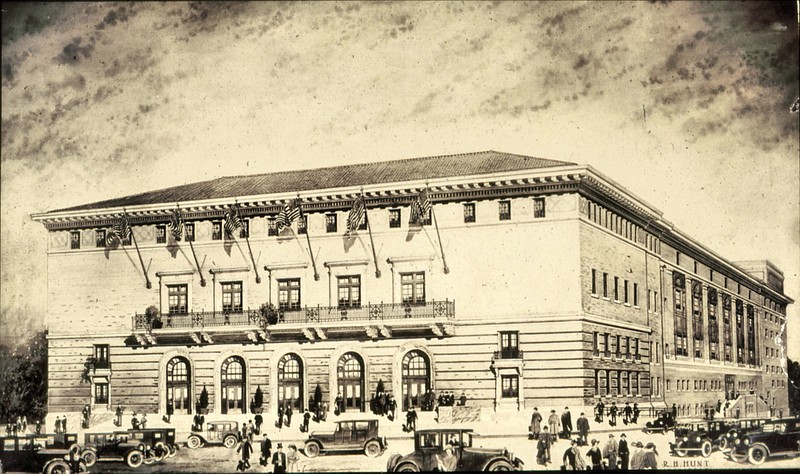Thousands drive by the building each week, often without realizing that the official name of the building is The Soldiers and Sailors Memorial auditorium, now referred to as Memorial Auditorium.
Dedicated in a two-day ceremony in February 1924, the massive structure was built to commemorate the region's "sons who offered their lives to the Nation's service in the great World War." In the dedication program, a more than 50-page bound volume, the committee explained its decision to build an auditorium. "We erect for posterity, in commemoration of their patriotism, a hall in which mementos of their achievement may rest; an auditorium in which great bodies of our people may assemble for civic service; for the cultivation of the arts; for the promotion of a higher and a broader citizenship. It is fitting that our tribute should take this form."
The Great War had touched every community in the nation. Family members, searching the newspapers for information about the Allied troops, followed their sons from the Argonne Forest to Chateau Thierry; they read about Germany's last push, the Great Spring Offensive, and the Allied forces entrenched along the Western front. The horrors of the war were all too present; stories of gas attacks, tanks and needle guns filled the nightmares of those watching from a distance. When an armistice was declared on Nov. 11, 1918, communities struggled to deal with the cost of this first world war and how they might honor the dead who had lost their lives so far from home.
In Chattanooga, the thoughts of constructing some type of a memorial began before the armistice. At a Kiwanis Club meeting at the Patten Hotel on Oct. 9, 1918, Dr. Harold Major, pastor of First Baptist Church and a Kiwanis member, addressed the group and suggested that there should be "a movement toward a memorial of some kind." Applause rang out in agreement, and a committee was formed to "consider the matter and report its conclusions." Committee members were D.H. Griswold, chairman, Dr. Harold Majors, and O.P. Darwin, president of the Kiwanis Club.
The Kiwanis committee then chose to invite representatives from every civic body in Chattanooga to attend an organizational meeting at the Chamber of Commerce on Nov. 15, 1918. However, before the city-wide meeting, the Kiwanis Club held its annual luncheon on Nov. 5, and the previously planned program gave way to a vigorous discussion of a "proposed memorial." Frank E. Mahoney proposed that there should be a "memorial hall," and the idea was presented at the community meeting 10 days later.
According to the minutes from that meeting, "almost every religious, charitable, cultural, commercial, industrial and patriotic organization was represented." After an extended discussion, those gathered elected an executive committee that was charged with considering the options for a memorial hall and to provide a report at a public meeting in January 1919. Executive Committee members elected were O.P. Darwin, chairman, Dr. Harold Majors, secretary, and members Neil J. Crowley, George H. Patten, W.E. Brock, D.H. Griswold, Z.W. Wheland, D.A. Landress, Milton B. Ochs, Fred Dearing and C.H. Huston.
The committee set to work and, within days, agreed that the concept of a memorial hall was an appropriate commemoration. In its January report, the committee noted that the building should be "sufficient size and equipment to serve at once as a municipal auditorium and as a memorial hall." They recommended that the City of Chattanooga furnish the funds for construction by a bonds sale not to exceed $400,000. The assembled delegates approved the proposal, and the executive committee was appointed to "take such further steps as might seem best to bring about the erection of the auditorium."
Chattanooga city attorney Frank S. Carden drafted a proposed act for the consideration of the Tennessee legislature which would authorize, the city to issue bonds in the sum of $400,000 for the "purpose of building a memorial auditorium and to provide for a special election as to the issuance of said bonds." The committee then presented the proposed act to the Chattanooga Board of Commissioners, i.e., Jesse M. Littleton, Mayor; T.C. Betterton, E.D. Herron, E.D. Bass and H.D. Huffaker, at their Jan. 28, 1919, meeting. It was endorsed unanimously and forwarded to the Hamilton County legislative delegation with the request that they "procure its passage" as soon as possible.
And then ...
Linda Moss Mines, the Chattanooga-Hamilton County historian, is regent, Chief John Ross Chapter, NSDAR.
